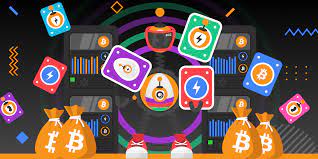In the rapidly evolving world of cryptocurrency, decentralization sunswap has emerged as a fundamental value, reshaping how transactions, investments, and exchanges are conducted. One of the most intriguing developments in this space is SunSwap, a decentralized exchange (DEX) built on the Tron blockchain. This platform is designed to provide seamless and efficient swapping of various digital assets, leveraging the decentralized nature of blockchain technology to offer a user-friendly and transparent experience.
What is SunSwap?
SunSwap is a decentralized exchange platform that facilitates the trading of tokens without the need for intermediaries or centralized control. Operating on the Tron blockchain, which is known for its high throughput and low transaction fees, SunSwap positions itself as a significant player in the realm of decentralized finance (DeFi). By utilizing an Automated Market Maker (AMM) system, SunSwap allows users to trade, swap, and provide liquidity to various cryptocurrencies in a decentralized manner.
SunSwap is part of the growing DeFi ecosystem, a movement that aims to replicate traditional financial services in a decentralized form, offering individuals more control over their assets and greater privacy. By using smart contracts and AMM protocols, SunSwap eliminates the need for traditional order books, offering a more efficient trading environment.
Key Features of SunSwap
- Decentralization: As a DEX, SunSwap allows users to trade directly with each other without relying on a centralized authority. This eliminates many of the risks associated with centralized exchanges, such as hacking or regulatory interference.
- Low Fees: Operating on the Tron blockchain, SunSwap benefits from one of the most efficient blockchains in terms of transaction fees. Compared to other platforms like Ethereum, Tron offers extremely low fees, making trading more cost-effective for users.
- Fast Transactions: The Tron network is known for its high throughput, processing thousands of transactions per second. This ensures that transactions on SunSwap are completed quickly, offering users an efficient experience even during periods of high demand.
- Liquidity Pools: SunSwap operates using an AMM model, where users can provide liquidity by contributing assets to pools. In return, liquidity providers earn a share of the fees generated from trades in the pool. This incentivizes users to contribute to the platform’s liquidity, creating a dynamic and efficient trading environment.
- SUN Token: SunSwap is closely tied to the SUN token, which serves as the platform’s native utility token. SUN holders can stake their tokens in liquidity pools, participate in governance decisions, and earn rewards. The SUN token has gained significant traction in the DeFi space due to its utility and the rewards it offers users.
- Staking and Yield Farming: SunSwap also offers opportunities for users to participate in yield farming by staking their tokens. Users can earn rewards by providing liquidity to the platform and participating in various farming pools. This has become an attractive feature for users looking to generate passive income from their crypto holdings.
The Role of SunSwap in the DeFi Ecosystem
SunSwap is part of the larger DeFi ecosystem, which aims to democratize finance by offering financial products and services in a decentralized manner. DeFi platforms are designed to provide users with more control over their assets, better accessibility, and often lower costs than traditional financial institutions.
By offering decentralized token swaps, liquidity provision, and staking, SunSwap helps to enhance the functionality of DeFi, enabling users to interact with their assets in a trustless and permissionless environment. Its integration with the Tron blockchain also gives it an edge in terms of speed and low costs, addressing some of the scalability issues faced by other blockchain platforms like Ethereum.
How SunSwap Differs from Centralized Exchanges
Centralized exchanges (CEXs) have long dominated the cryptocurrency trading space. However, they come with several drawbacks, including the risk of hacks, regulatory challenges, and the need for users to trust the platform’s management. SunSwap, as a decentralized exchange, solves many of these issues.
- Trustless Transactions: On SunSwap, users retain full control of their assets at all times. Since it operates on smart contracts, there is no need for users to trust a third party with their funds.
- Privacy: As a decentralized platform, SunSwap does not require users to submit personal information or go through lengthy verification processes. This aligns with the ethos of privacy and security that is central to the cryptocurrency space.
- Reduced Risk of Hacks: While no platform is entirely free from risks, decentralized exchanges like SunSwap typically have fewer vulnerabilities than centralized platforms. Since funds are stored in users’ wallets and not on the exchange, there is less of an opportunity for hackers to steal large amounts of crypto.
- No Geographical Restrictions: Centralized exchanges often have to comply with regulatory requirements in different jurisdictions, which can restrict access for certain users. SunSwap, being decentralized, operates globally and does not impose restrictions based on geographical location.
The Future of SunSwap
The future of SunSwap looks promising, as decentralized exchanges continue to gain traction in the crypto space. As more users embrace the benefits of decentralization, SunSwap’s user base is likely to grow, especially given the increased demand for lower-cost, faster transactions that it offers through the Tron blockchain.
Furthermore, as DeFi continues to evolve, SunSwap is likely to introduce new features and enhancements to stay competitive. This could include additional yield farming opportunities, more token integrations, and improvements to its user interface and experience.
Additionally, the SUN token could become even more integral to the DeFi ecosystem, serving as a key component in governance, staking, and liquidity provision. The growing adoption of the Tron blockchain, coupled with SunSwap’s innovative approach to decentralized trading, makes it an exciting project to watch in the years to come.
Conclusion
SunSwap represents a step forward in the evolution of decentralized finance, offering a user-friendly, low-cost, and highly efficient platform for trading digital assets. By leveraging the power of the Tron blockchain, SunSwap provides a unique solution that addresses many of the shortcomings of traditional exchanges, including high fees, slow transactions, and centralization risks.
As the DeFi ecosystem continues to grow, SunSwap’s role in reshaping the future of finance becomes increasingly important. Its decentralized model empowers users to take full control of their assets, and with its low fees, fast transactions, and liquidity incentives, it is well-positioned to become a dominant player in the space. Whether you are a beginner in the crypto world or a seasoned investor, SunSwap offers an exciting opportunity to be part of the decentralized financial revolution.

